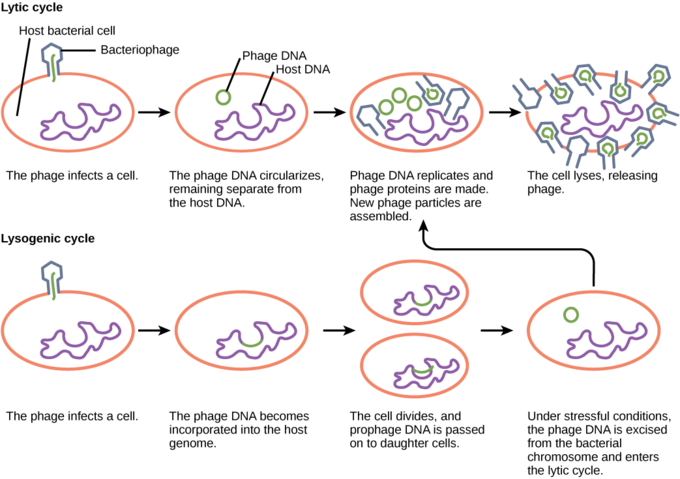Hich Best Describes the Lytic and Lysogenic Cycles
Lysogeny or the lysogenic cycle is one of two cycles of viral reproduction. A host cell that is infected by a lysogenic virus will only die if.

What Are The Advantages Of Entering A Lysogenic Cycle Lisbdnet Com
Symptoms of infection appear in the lysogenic cycle but not in the lytic cycle.

. The virus enters the lytic cycle the virus enters the host chromosome the viruses stays in the lysogenic cycle any of the above A the virus enters the lytic cycle All viruses are made of proteins and a. An example of a bacteriophage known to follow the lysogenic cycle and the lytic cycle is the phage lambda of E. Symptoms of infection appear in the lysogenic cycle but not in the lytic cycle.
There are several differences between the lytic and lysogenic cycle. Unlike the lytic cycle the lysogenic cycle involves production of virus particles. The main difference between lytic cycle and lysogenic cycle is that lytic cycle destroys the host cell whereas lysogenic cycle does not destroy the host cell.
Which best describes the lytic and lysogenic cycles. Unlike the lysogenic cycle the lytic cycle involves destruction of the host. The cycles produce thousands of copies of the original virus.
The difference between lysogenic and lytic cycles is that in lysogenic cycles the spread of the viral DNA occurs through the usual prokaryotic reproduction whereas a lytic cycle is more immediate in that it results in many copies of the virus being created very quickly and the cell is destroyed. Put your understanding of this concept to test by answering a few MCQs. Unlike the lysogenic cycle the lytic cycle involves destruction of the host.
Which best describes viruses. These are mentioned below. What triggers a switch from the lysogenic to lytic cycle.
However in the lysogenic cycle viral DNA may merge with the host DNA. Unlike the lysogenic cycle the lytic cycle involves destruction of the host. Environmental stimuli such as stress due to exposure to UV light or a sudden decrease in the levels of dissolved oxygen can cause the phage to exit.
A viral reproductive cycle in which the viral DNA is added to the host cells DNA and is copied along with the host cells DNA. The main difference between lytic cycle and lysogenic cycle is that lytic cycle destroys the host cell whereas lysogenic cycle does not destroy the host cell. Lysogeny is characterized by integration of the bacteriophage nucleic acid into the host bacteriums.
For virulent viruses the lysogenic cycle is the main way of replicating. Both are mechanisms of viral reproduction. Unlike the lytic cycle the lysogenic cycle involves production of virus particles.
Transition from lysogenic to lytic. Which best describes the lysogenic cycles. First of all in the lytic cycle the bacteriophages take over the host takes over the cells metabolism injecting its DNA and protein into the cell causing new synthesis of proteins and nucleic acids.
The average instantaneous velocity of a particle in solution-that is the velocity between the very frequent collisions-is vk T m1 2 where k138 times 10-16 mathrmg mathrmcm2 mathrmK. Unlike the lysogenic cycle the lytic cycle involves destruction of the host. Both lytic and lysogenic can moderate the DNA replication and the protein synthesis of the host cell.
For virulent viruses the lysogenic cycle is the main way of replicating. Viral DNA destroys the host cell DNA and arrests the cell functions in the lytic cycle. Viral DNA destroys the host cell DNA and arrests the cell functions in the lytic cycle.
The main difference between the lysogenic cycle and lytic cycle is their influence on the host cell. The difference between lysogenic and lytic cycles is that in lysogenic cycles the spread of the viral DNA occurs through the usual prokaryotic reproduction whereas a lytic cycle is more immediate in that it results in many copies of the virus being created very quickly and the cell is destroyed. Then they assemble and form complete bacteriophage particles.
A viral reproductive cycle in which copies of a virus are made within a host cell which then bursts open releasing new viruses. In the lysogenic cycle a virus does not kill the host. Endospores A Nucleic Acids.
The main difference between lytic cycle and lysogenic cycle is that lytic cycle destroys the host cell whereas lysogenic cycle does not destroy the host cell. Regarding the other statements in the lytic cycle symptoms of infection appear and also it is the main way of. They take place within the host cell.
Read More Which best describes the lytic and lysogenic cycles. At BYJUS learn more differences like the difference between replication and transcription. Which best describes the lytic and lysogenic cycles.
B Most of the prophage genes are activated by the product of a particular prophage gene. A After infection the viral genes immediately turn the host cell into a lambda-producing factory and the host cell then lyses. Which of the following statements accurately describes the lysogenic cycle of lambda λ phage.
Which best describes the lytic and lysogenic cycles. Discuss the following problem. Test your Knowledge on Lytic And Lysogenic Cycle.
Viral DNA destroys the host cell DNA and arrests the cell functions in the. The lytic and the lysogenic cycle also have many similarities. Diffusion sounds slow-and over everyday distances it is-but on the scale of a cell it is very fast.

Lytic Vs Lysogenic Understanding Bacteriophage Life Cycles Technology Networks

Lytic Vs Lysogenic Understanding Bacteriophage Life Cycles Technology Networks

No comments for "Hich Best Describes the Lytic and Lysogenic Cycles"
Post a Comment